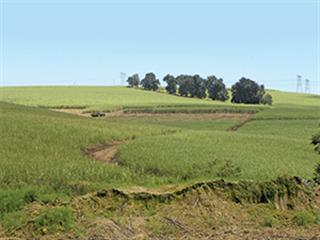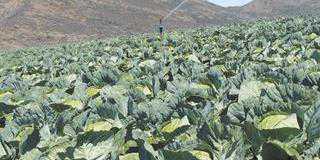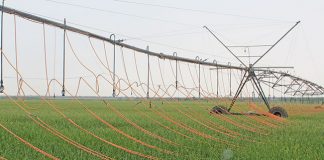
Many young farmers work alongside their fathers when they first start out on the family farm, benefiting from years – if not generations – of hard-earned expertise. But Upper Tongaat sugarcane farmer Anthony Goble didn’t have that privilege. His father Neil passed away in 2000 when Anthony was still at university and when he returned to the farm three years later, at the age of 22, he was rudderless without his father’s guidance.
But this lack of parental prescription left Anthony free to develop his own farming systems. He did so by putting his agronomic theories to the test and integrating successful ones into a practical, continuously evolving system.

Anthony with his wife Tanya, their children Benjamin and James, and his mother Kathryn.
The operations
Anthony’s great great great grandfather, Captain Richard Holmes Goble, arrived in Upper Tongaat in the 1870s, making Anthony the sixth generation in the area and the fourth generation on the 280ha family farm, Evelyn Park. Anthony and his mother Kathryn own another 420ha cane land nearby and have leased 340ha cane land from land reform beneficiaries, bringing their total area under cane to 1 000ha, with 300ha of natural bush.
Anthony has diversified into bananas (12ha) and macadamias (5ha) but cane makes up 99% of the income on these predominantly rainfed farms, which have many characteristics common to the coastal and Zululand regions: acid soil, steep slopes and a high incidence of the stalk borer, Eldana saccharina. The farms average 64t/ha of cane which is in the top 10% of the mill area but relatively low compared to yields in the Midlands areas of Dalton where yields often average 90t/ha to 100t/ha.
To improvce yields in a sustainable manner, Anthony began introducing best management practices (BMPs), focusing on a replant programme; liming and green manuring; and controlling eldana. CanePro record keeping software and a land use plan from the SA Sugar Research Institute form the basis of the farm improvement plan and data is captured religiously by Anthony’s wife Tanya to measure progress.
Key focus areas
Anthony initiated an extensive four-year replant programme in 2009, stripping out 487ha of underperforming lands and unsuitable varieties and restoring 340ha of neglected leased land. The lands were replanted with new, more promising varieties, such as N37, N39, N45, N48 and N51. On the 180ha which receives supplementary irrigation, N40 was planted.
Production on one of the leased farms doubled to 4 000t in 2012 and should double again to 8 000t this year.
‘‘Production on the leased farms in total has doubled from 5 000t in 2009 to 10 000t in 2012 and should increase to 17 000t in 2013, as they are now fully restored to close to productive capacity,” Anthony says. Side-loaders are used in-field instead of Bell loaders to extend the longevity of these newly planted lands. “Cane was dying off after four ratoons instead of eight to 10 ratoons. We think it was because Bell loaders were being driven over the stools. Now that we are using side-loaders, damage is less and we think replanted lands will last a lot longer.”

Madumbi farmers lease 20ha from Anthony annually. This breaks the monocrop and is followed by an application of lime, if necessary, followed by a seedcane crop.
Building healthier soil with increased organic matter is another key focus area. Over the past four years, Anthony has spent considerable effort balancing subsoil acidity with applications of lime and gypsum. “We also use 8t/ha chicken litter and 40t/ha filter press from the sugar mill to build up sandy soil. Soil samples are taken of every land to measure progress and pick up problems right away,” he says.
A liming and green manuring schedule is planned three years in advance, with 5% of lands planted to green manure crops annually. Some of these lands will lie fallow for 12 months, while others will lose no production time. “Lands that are cut as soon as the mill opens in April are planted to black oats in winter and replanted to cane in September so they don’t lose any production time. Lands that are cut later in the season (from September to December) are planted to sunn hemp in summer and black oats in winter and replanted with cane the following September.”
The green manure crop is chopped down and worked into the soil, along with filter press and lime, prior to being replanted with sugarcane. “We only want to replant lands every 10 to 15 years so we must make sure to get enough lime in when we have the opportunity,” Anthony explains. He has seen huge improvements in the soil and the crop on lands that have followed this programme. “Some acid saturation has gone from 60% to 1% and yields on different lands have risen from 31t/ha to 115t/ha and from 71t/ha to 141t/ha,” he recalls.
There are a number of other benefits to the green manuring programme: “Sunn hemp releases nitrogen in the soil and black oats emit a toxin that works quite well against Cynodon. Oats also seems to offer benefits against nematodes. Soil samples of lands planted with black oats show that nematode populations are so low it is not even worth treating for them.”
Another major pest in this area is eldana. In 2000, Anthony went from cutting 66% of the farm annually to cutting 80%, as eldana prefers an older crop. “The yield difference between cutting 80% of cane and cutting 66% is about 20t/ha. Anthony is currently managing eldana by spraying via a tractor-mounted mist blower. “We spray eight times a year from August to April on cane we are not going to cut that season.
“We do not want to zap everything with chemicals, but the spray programme is giving us a chance to age our cane and introduce push-pull plants to attract eldana away from the cane, such as papyrus in the valley bottom and molasses grass in the contours. He also believes that if soil nutrition is good, cane will be less stressed and it will not be eldana’s first choice.

Loading zones are carefully planned to minimise the distance tractors have to travel. Anthony prefershaulage trucks to travel a bit further instead.
That is why they have made a strong push to address soil acidity and deficiencies of calcium and magnesium. “When we have done this, eldana will be under control and we can start ageing the cane to harvest at 18 months instead of 14 to 15 months. This, together with the newer varieties that we have planted, should help us achieve a crop of between 80t and 100t cane per hectare in the next few years.”
In the quest to improve the farm and follow BMPs, Anthony has opened another income stream – that of seedcane. He leases out 20ha per year to madumbi (yam) growers and after a year, those lands are used as clean seed beds. “By restoring soil health on fallow areas and by putting in new varieties as part of the replant programme, we have been able to bulk up seedcane to the extent that we can sell it.
Seedcane is a huge opportunity to even out cash flow during the off-crop. Seedcane is sold at 12 months whereas cane is milled at 18 months so the return on those lands is quicker.” The farm’s cash flow is also benefiting from a haulage company which Anthony formed in 2009 with eight relatives in the area. Three existing haulage rigs were pooled and the syndicate bought a fourth one, making the 45km trip to Gledhow Mill much more affordable. Last year the syndicate helped Anthony realise a 30% saving on his transport costs.
“We strive to continuously improve and are always looking for opportunities to save money or create new income streams,” he explains. “But at the same time, you have to look after the goose that lays the golden egg. I put as much as I can back into the farm to maximise that next crop.”
Contact Anthony Goble on 082 681 1542 or [email protected]













